-
01-01-2016
Leads for potentializing groups in Primary Health Care
Revista Brasileira de Enfermagem. 2016;69(5):964-971
Abstract
Leads for potentializing groups in Primary Health Care
Revista Brasileira de Enfermagem. 2016;69(5):964-971
DOI 10.1590/0034-7167-2015-0102
Views0See moreABSTRACT
Objective:
to analyze the aspects that potentialize groups in Primary Health Care according to their coordinators and participants.
Method:
This is a descriptive study with a qualitative approach, conducted with a health promotion group affiliated with a Family Health Unit. The data were collected by means of focus groups with participants and community workers who were submitted to thematic content analysis.
Results:
the analysis gave rise to three thematic categories: The group is our medicine; Healthy living and learning; and Priceless leadership.
Conclusion:
the leads identified during the study were as follows: group organization involves investment in motivation and leadership by the coordinators; production of grouping and cohesion is a result of participants and coordinators meeting together, interspersed with dialog, things said and left unsaid that the subjects expressed in the group dynamic; the sense of belonging guarantees their placement in the group based on the recognition of their knowledge and affective, social and health needs.
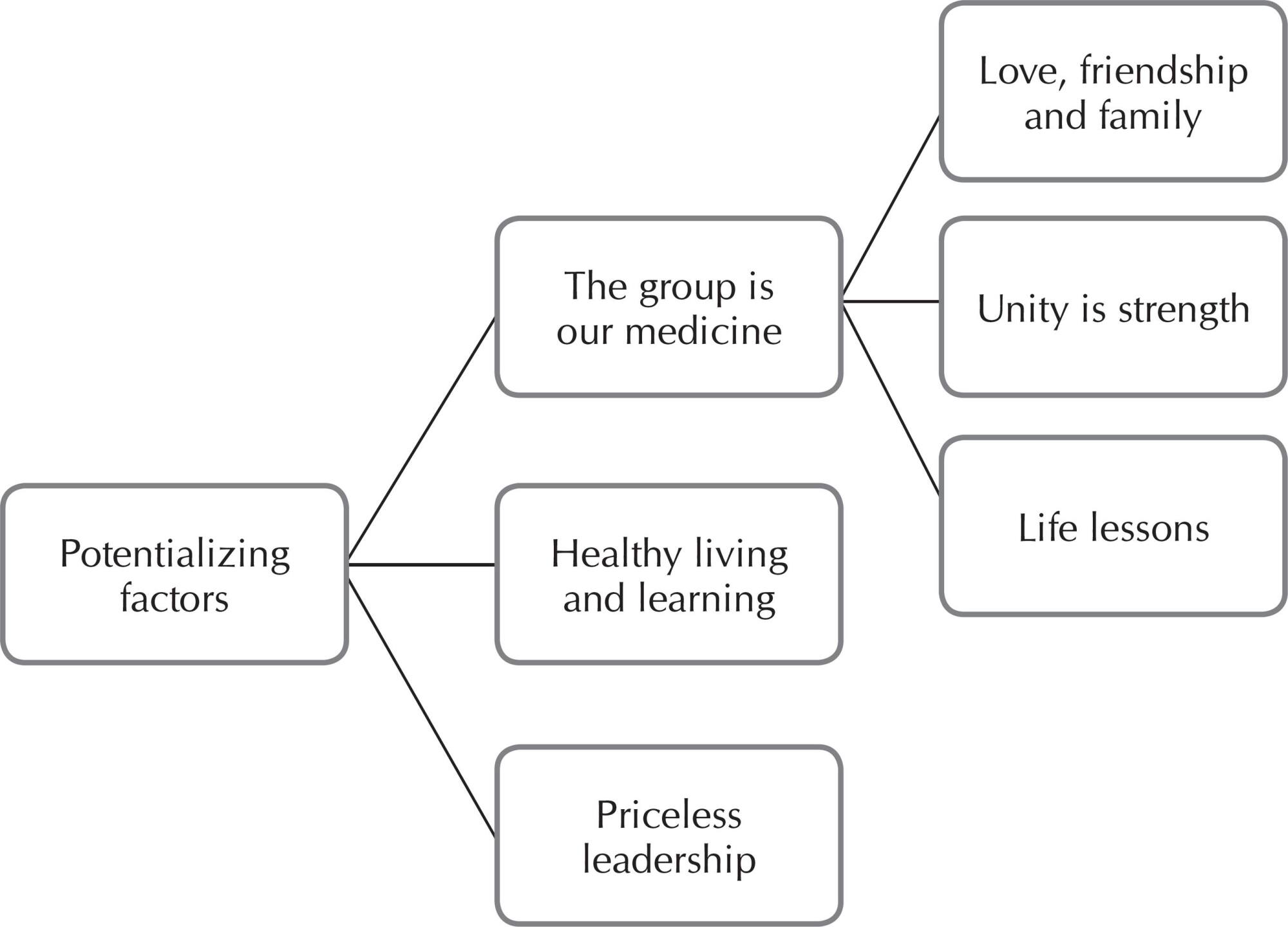
-
01-01-2016
The path to crack addiction: perceptions of people under treatment
Revista Brasileira de Enfermagem. 2016;69(5):956-963
Abstract
The path to crack addiction: perceptions of people under treatment
Revista Brasileira de Enfermagem. 2016;69(5):956-963
DOI 10.1590/0034-7167-2016-0045
Views0See moreABSTRACT
Objective:
the objective of this study was to understand the meaning of the harmful use of crack by people undergoing addiction treatment.
Method:
qualitative approach of social research on strategic modality was used. Field observation, preparation of field diary and focus groups, and data analysis through the method of interpreting meaning were carried out.
Results:
the results contributed to the construction of three thematic categories: “The discovery of crack and other drugs” that describes the experimentation with crack and other drugs; “The pain of the pleasure”, key category that describes the moments after crack experimentation and that, many times, turns into addiction, which leads the person into a cycle of short periods of attempts at abstinence, relapse, and relentless consumption; and “Return to normal life”.
Conclusion:
treating people with crack addiction must be carried out in ways that narrow the distance between these people and their families, society and health care.
-
01-01-2016
Intimate partner violence in adolescence: an analysis of gender and generation
Revista Brasileira de Enfermagem. 2016;69(5):946-955
Abstract
Intimate partner violence in adolescence: an analysis of gender and generation
Revista Brasileira de Enfermagem. 2016;69(5):946-955
DOI 10.1590/0034-7167-2016-0408
Views0See moreABSTRACT
Objective:
to analyze the intimate partner violence in adolescence from the perspective of gender and generation.
Method:
Quantitative, descriptive, and exploratory research. 111 adolescents participated in this study, with ages from 15 to 19 years old.
Results:
We found that 91% of participants have perpetrated and 90.1% have undergone at least one of the natures of violence. The intimate partner violence in adolescence constitutes a form of gender violence, and gender constructions have determined the suffered and perpetrated aggressions, possibly also determining the naturalization and legitimization of such aggressions. The inequality of power between generations may determine greater vulnerability of youngsters to the phenomenon.
Conclusion:
The historical and social construction of masculinity and femininity and the power inequalities set by these constructions converge with the power inequality between generations. Thus, gender and generation are determinants of intimate partner violence in adolescence, as well as of the vulnerability of adolescents to this phenomenon.
-
01-01-2016
Hospitalization anxiety in children: conceptual analysis
Revista Brasileira de Enfermagem. 2016;69(5):940-945
Abstract
Hospitalization anxiety in children: conceptual analysis
Revista Brasileira de Enfermagem. 2016;69(5):940-945
DOI 10.1590/0034-7167-2015-0116
Views0See moreABSTRACT
Objective:
to analyze the concept “hospitalization anxiety in children”, identifying its antecedents, attributes, and consequences, with the objective of clarifying its meaning.
Method:
we used a conceptual analysis model, whose objective is to clarify the meaning of terms.
Results:
we identified the concept antecedents and its attributes, classified as biological and psychological needs, which are essential characteristics of “hospitalization anxiety in children”. This process consequences have also been identified. We proceeded to the analysis of the characteristics with emphasis on the impacts of the hospitalization process on the child and on the family.
Conclusion:
based on the conceptual analysis of the phenomenon, it was possible to identify the antecedents, attributes, and consequences of Hospitalization Anxiety in children. We recommend the continuation of the study validating the essential characteristics presently identified as a way to join knowledge gathered and professional practice.
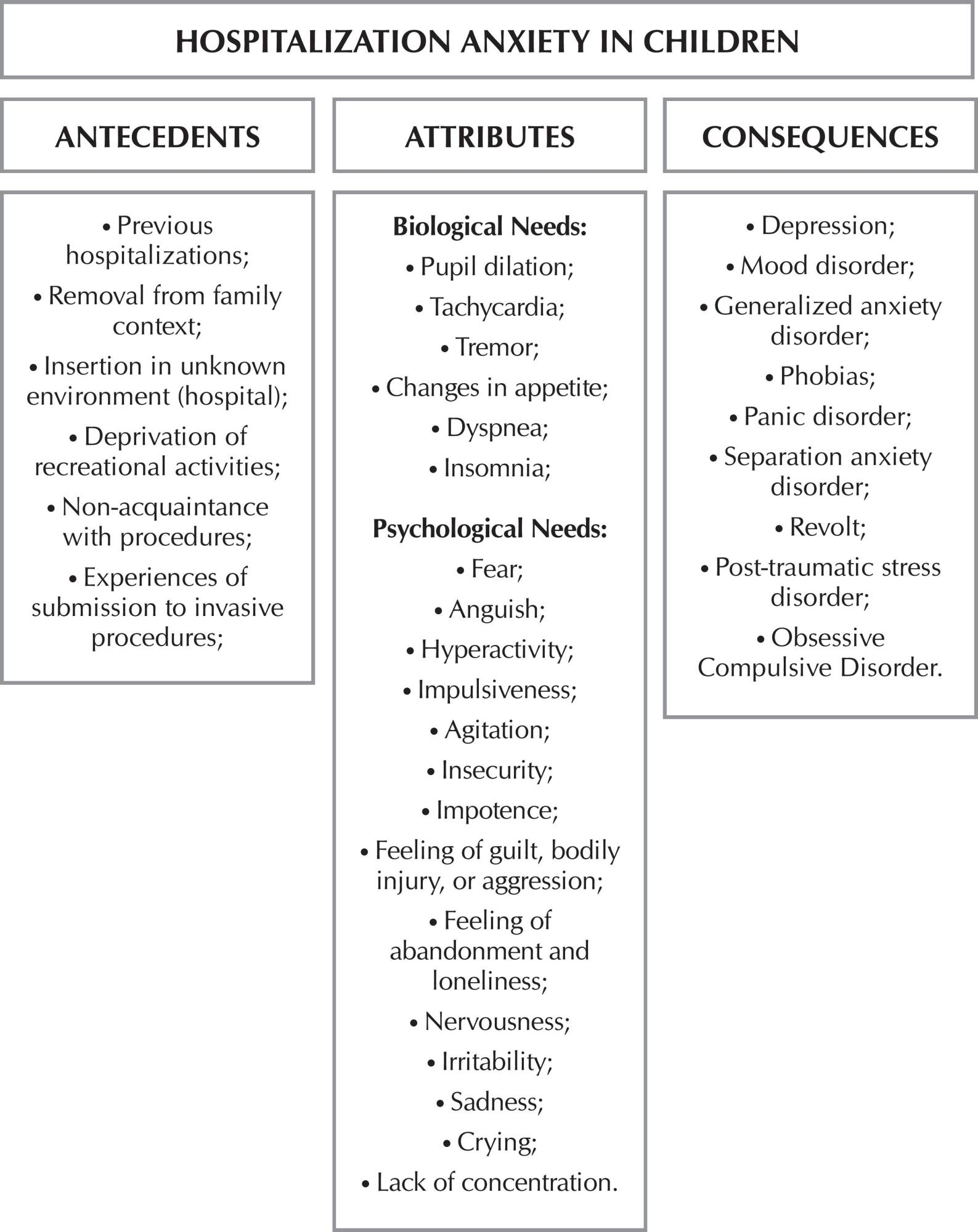
-
01-01-2016
Stroke: patient characteristics and quality of life of caregivers
Revista Brasileira de Enfermagem. 2016;69(5):933-939
Abstract
Stroke: patient characteristics and quality of life of caregivers
Revista Brasileira de Enfermagem. 2016;69(5):933-939
DOI 10.1590/0034-7167-2015-0064
Views0See moreABSTRACT
Objective:
to investigate the association between the domains of health-related quality of life of family caregivers and sociodemographic characteristics of individuals with stroke sequelae.
Method:
descriptive, cross-sectional, quantitative research, conducted with 136 family caregivers of individuals with stroke sequelae by means of home interviews from April to June 2013.
Results:
we found that caregivers of individuals aged under 65 years, married, with 10 to 12 years of formal education, presented higher scores, respectively, in the domains ‘Social aspects’, ‘Emotional aspects’, and ‘Mental health’. However, caregivers of patients with higher degree of disability obtained lower score in the ‘Mental Health’ domain.
Conclusion:
the results foster reflection on the need of including the family caregivers of individuals with stroke sequelae in the planning of care provided by health professionals.
-
01-01-2016
A quasi-experimental nursing study on pain in comatose patients
Revista Brasileira de Enfermagem. 2016;69(5):927-932
Abstract
A quasi-experimental nursing study on pain in comatose patients
Revista Brasileira de Enfermagem. 2016;69(5):927-932
DOI 10.1590/0034-7167-2015-0121
Views0See moreABSTRACT
Objective:
to verify whether comatose patients feel pain during the bed bath nursing procedure.
Method:
nineteen patients aged 61 ± 17.39 years participated in the study. A quantitative analysis was conducted on the P substance (PS) in the saliva collected before and during a bed bath, using the ELISA method. Program Graph Pad Prisma 6 was used to analyze the data. The verification of normality was made through the Shapiro Wilk test, which determined the choice for the Wilcoxon nonparametric test.
Results:
the study showed a statistically significant increase (∆= 5.62%, p<0.001) in the PS level of the patients studied during the nursing procedure.
Conclusion:
when caring for comatose patients during a bed bath, professionals cause or add painful stimuli; therefore, they feel pain.
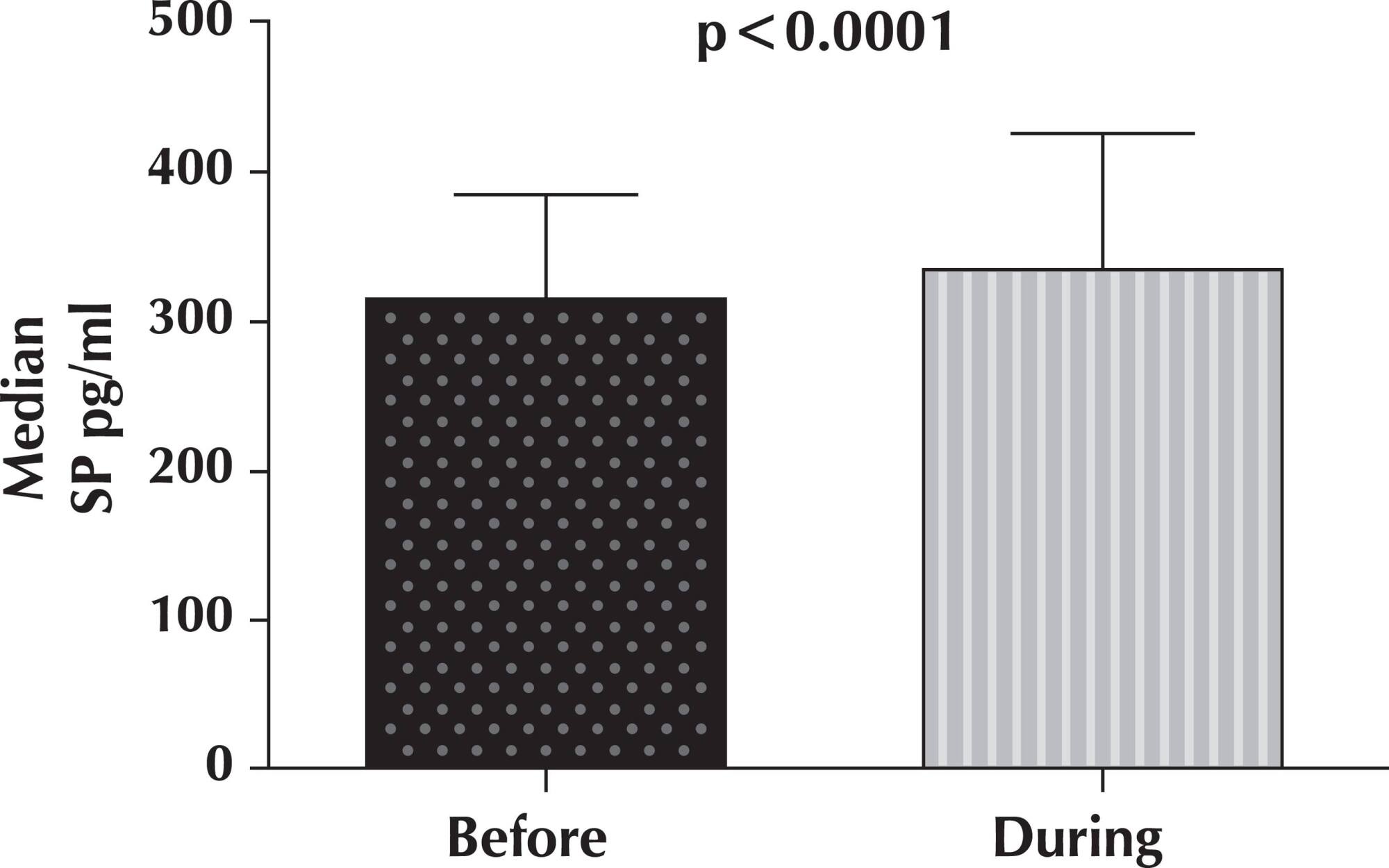
-
01-01-2016
Quality of nursing care: instrument development and validation
Revista Brasileira de Enfermagem. 2016;69(5):920-926
Abstract
Quality of nursing care: instrument development and validation
Revista Brasileira de Enfermagem. 2016;69(5):920-926
DOI 10.1590/0034-7167-2015-0151
Views0See moreABSTRACT
Objectives:
to describe the development and validation process of a scale to measure the nurses’ perception of the activities that contribute to nursing care quality.
Method:
methodological study based on a literature review, the opinion of experts and the experience of study investigators. An instrument was designed containing six dimensions and 25 items, applied as a questionnaire to 775 nurses from a hospital in northern Portugal, from May to July 2014. The instrument validation used an exploratory factor analysis and an internal consistency assessment of each factor/dimension.
Results:
the factor analysis indicated the need to adjust the original composition of the scale, which then received one more dimension, totaling seven dimensions and the same 25 items, and presented a high internal consistency (Cronbach’s alpha of 0.940).
Conclusion:
the final version of the scale presents adequate psychometric properties, with potential use in future studies.
-
01-01-2016
Network and social support in family care of children with diabetes
Revista Brasileira de Enfermagem. 2016;69(5):912-919
Abstract
Network and social support in family care of children with diabetes
Revista Brasileira de Enfermagem. 2016;69(5):912-919
DOI 10.1590/0034-7167-2015-0085
Views0See moreABSTRACT
Objective:
to understand the influence of network and social support in the care of a child with type 1 diabetes.
Method:
qualitative study, with assumptions of ethnonursing, conducted in a reference service specialized in the treatment of diabetes, in 2014, in the city of Fortaleza, state of Ceará, Brazil. Twenty-six members of the family and their respective school children participated in the study. The process of collection and analysis followed the observation-participation-reflection model.
Results:
the analytical categories showed that the social network in the care of children with diabetes helped sharing of information and experiences, moments of relaxation and aid in the acquisition of supplies for treatment, with positive repercussions in the family context, generating well-being and confidence in the care of children with diabetes.
Conclusion:
the cultural care provided by nurses strengthens the network and social support because it encourages autonomy in the promotion of the quality of life of children with type 1 diabetes and their families.
-
EXPERIENCE REPORT02-10-2020
Overcoming the challenges to offer quality training in psychiatric nursing
Revista Brasileira de Enfermagem. 2020;73(1):e20180208
Abstract
EXPERIENCE REPORTOvercoming the challenges to offer quality training in psychiatric nursing
Revista Brasileira de Enfermagem. 2020;73(1):e20180208
DOI 10.1590/0034-7167-2018-0208
Views0See moreABSTRACT
Objective:
to report the experience of the Psychiatric Nursing professors of the Nursing Undergraduate Course of the Nursing School, Universidade Federal de Minas Gerais (UFMG) and the challenges faced to offer quality training.
Method:
This is an experience report about the experience of Psychiatric Nursing professors of the Nursing Undergraduate Course of the Nursing School, UFMG.
Results:
After losing the workload of 120 hours in the Psychiatric Nursing Undergraduate Course, the area developed elective disciplines with a total of 330-hour load, in addition to extension and research projects.
Final considerations:
the precariousness of the area of Nursing training after curricular restructuring in a higher education institution, whether in relation to hour load or in the allocation of teaching vacancies, is in line with advances of the Brazilian Psychiatric Reform and epidemiological data of psychic illness and drug use.
-
REVIEW07-31-2020
Educational practices for families of children and adolescents using a permanent venous catheter
Revista Brasileira de Enfermagem. 2020;73:e20190129
Abstract
REVIEWEducational practices for families of children and adolescents using a permanent venous catheter
Revista Brasileira de Enfermagem. 2020;73:e20190129
DOI 10.1590/0034-7167-2019-0129
Views0See moreABSTRACT
Objectives:
to identify, in the scientific literature, the educational practices performed by nurses with the families of children and adolescents using long-term venous catheters, concerning home care.
Methods:
integrative review in LILACS, PubMed, SCOPUS, Web of Science and CINAHL databases, from August to September 2018.
Results:
we analyzed eight articles that met the inclusion criteria. The results showed that all studies are international, mostly North American and with low level of evidence. The educational practices found were home visits, production of printed educational materials, use of mannequins for simulation, creation of an educational video, and combined educational practices.
Final Considerations:
the care provided by families at home in the countries studied is more complex than in Brazil, and the conclusion is that Brazilian studies need to advance in publications related to this area.
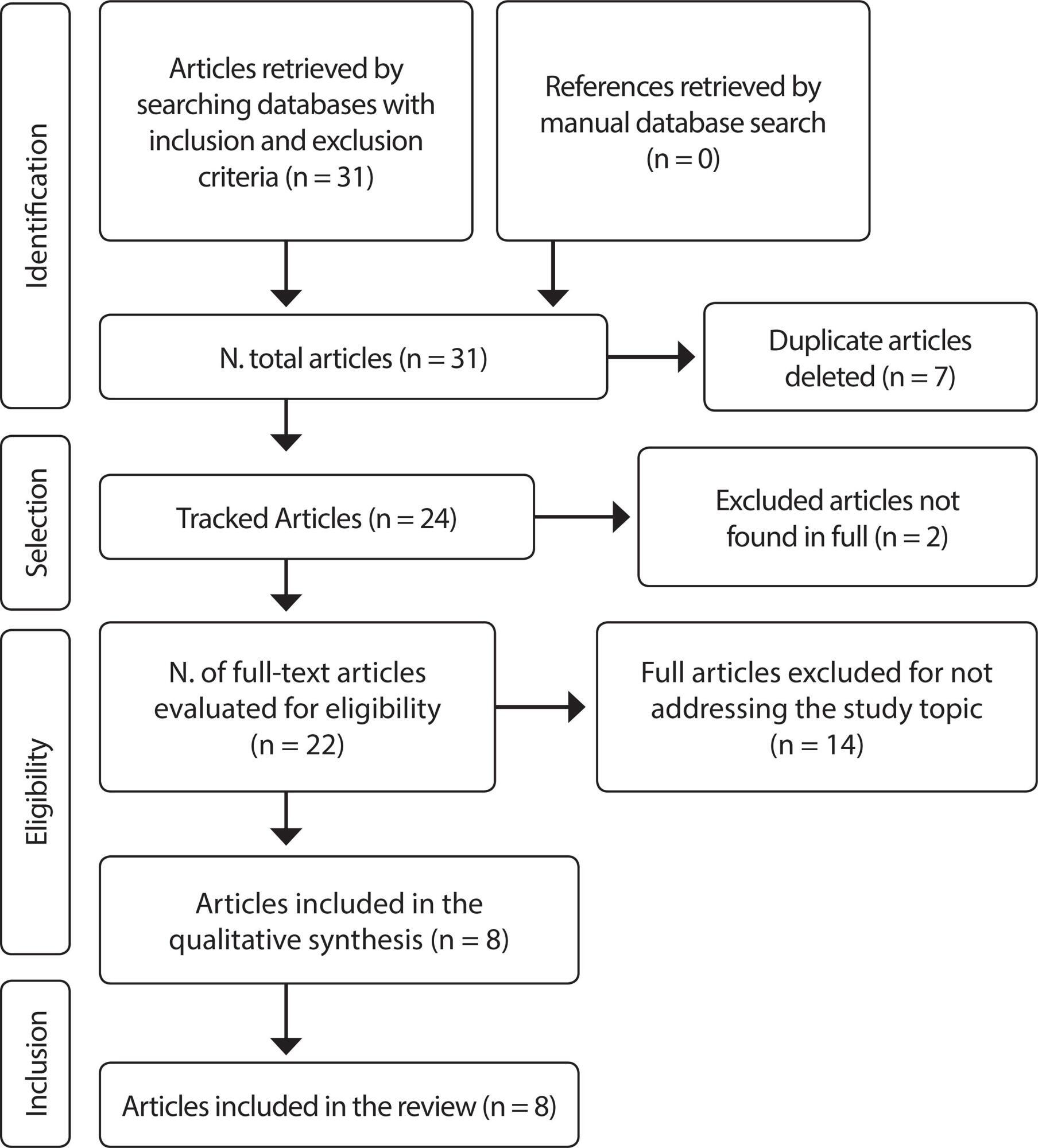
-
ORIGINAL ARTICLE02-06-2023
Teaching entrepreneurship in undergraduate Nursing course: evaluation of an educational proposal
Revista Brasileira de Enfermagem. 2023;76(2):e20210244
Abstract
ORIGINAL ARTICLETeaching entrepreneurship in undergraduate Nursing course: evaluation of an educational proposal
Revista Brasileira de Enfermagem. 2023;76(2):e20210244
DOI 10.1590/0034-7167-2021-0244
Views1See moreABSTRACT
Objective:
To evaluate a proposal for teaching entrepreneurship in an undergraduate Nursing course that uses active methodologies and activities based on the theory of meaningful learning.
Methods:
Interventional, prospective study, with a quantitative perspective, with a total of 102 participating students, carried out from July 2017 to December 2019 at a public university in the state of Sao Paulo. Statistical analysis were performed by non-parametric Chi-square or Fisher’s exact tests, with differences considered statistically significant if p < 0.05.
Results:
Improvements were observed in almost all items evaluated, revealing that meaningful learning became more effective with the use of active teaching methodologies. Most students need adaptation and effort to be put into these methods.
Conclusions:
The proposal offers pedagogical content adaptation, specifically for nursing students. New research should expand teaching-learning techniques for the development of future nurses, preparing them adequately for the job market.
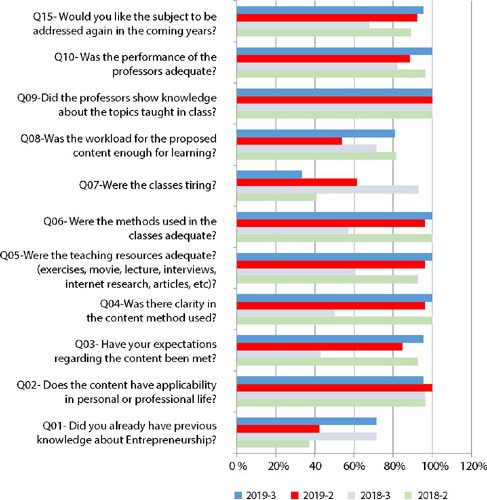
-
ORIGINAL ARTICLE08-16-2021
Gender debate as a challenge in nursing training
Revista Brasileira de Enfermagem. 2021;74(5):e20201001
Abstract
ORIGINAL ARTICLEGender debate as a challenge in nursing training
Revista Brasileira de Enfermagem. 2021;74(5):e20201001
DOI 10.1590/0034-7167-2020-1001
Views0See moreABSTRACT
Objectives:
to understand the challenges of introducing gender debate in nursing training from undergraduate students’ perspective.
Methods:
a qualitative, exploratory-explanatory study. Data were collected through a semi-structured interview applied to 12 undergraduate nursing students at a public university in São Paulo. For data treatment and analysis, the Discourse of the Collective Subject was used in light of Boaventura de Sousa Santos’ knowledge production paradigm theoretical framework.
Results:
nursing education remains centered on the traditional scientific model, neglecting gender and strengthening stereotypes aimed at the feminization of the profession.
Final Considerations:
nursing training has a challenge of implementing actions that deepen the gender theme. Therefore, some strategies are suggested, such as improving professor training and appropriating emancipatory pedagogical practices; reviewing pedagogical political projects; curriculum theorization and restructuring; problematizing gender issues for nursing leadership.
-
ORIGINAL ARTICLE08-30-2021
Historical aspects in pain management in palliative care in an oncological reference unit
Revista Brasileira de Enfermagem. 2021;74(5):e20200761
Abstract
ORIGINAL ARTICLEHistorical aspects in pain management in palliative care in an oncological reference unit
Revista Brasileira de Enfermagem. 2021;74(5):e20200761
DOI 10.1590/0034-7167-2020-0761
Views0See moreABSTRACT
Objective:
Describe the actions implemented for pain management in palliative care oncology and analyze the contribution of Hospital do Câncer IV, as a reference unit at the National Cancer Institute.
Methods:
Study of the history of the present time, whose sources were written documents and interviews with five participants. The collection took place from February to June 2018. The analysis of the written sources took place through internal and external criticism of the documents, considering their chronology and theme.
Results:
Professionals contributed with actions for pain management in palliative oncology care: in discussions and final drafting of ordinances, as rapporteurs at national and international events, in the elaboration of humanization conducts and systematization of assistance in addressing pain.
Final considerations:
These actions favored assistance in palliative oncology care at various levels of health care for patients and families, with greater technical and scientific recognition for all.
-
TECHNOLOGICAL INNOVATION06-04-2021
Development of a nursing website for critical care regarding healthcare-associated infections
Revista Brasileira de Enfermagem. 2021;74:e20200928
Abstract
TECHNOLOGICAL INNOVATIONDevelopment of a nursing website for critical care regarding healthcare-associated infections
Revista Brasileira de Enfermagem. 2021;74:e20200928
DOI 10.1590/0034-7167-2020-0928
Views0See moreABSTRACT
Objective:
to describe the development of a website about the main healthcare-associated infections and the respective bundles to prevent these diseases, oriented toward intensive care unit nursing.
Methods:
experience report describing the development of technological innovation by nurses, using computational tools and technological production methodological research and following the product development process.
Results:
nurses developed an educational website which can be accessed through computers, tablets, and smartphones at the electronic address irastis.com and focuses on healthcare-associated infections.
Final considerations:
digital technologies have contributed to fulfill demands in health care, research, and education. The developed website has the potential to support reduction in healthcare-associated infection rates, since it makes preventive measures for these infections available and refers users to publication environments that systematize the implementation of the bundles.

-
ORIGINAL ARTICLE10-21-2019
Being an institutionalized elderly person: meaning of experiences based on Heidegger’s phenomenology
Revista Brasileira de Enfermagem. 2019;72(6):1632-1638
Abstract
ORIGINAL ARTICLEBeing an institutionalized elderly person: meaning of experiences based on Heidegger’s phenomenology
Revista Brasileira de Enfermagem. 2019;72(6):1632-1638
DOI 10.1590/0034-7167-2018-0763
Views0See moreABSTRACT
Objective:
Analyze the meaning of being an elderly person living in a long-term institution.
Method:
Qualitative study based on Martin Heidegger’s thought. Twelve phenomenological interviews were conducted with people aged over 60 years living in a long-term institution for the elderly in the city of Itabuna, Bahia, Brazil.
Results:
The units of meaning identified were: experience of progressive loss of autonomy and independence, perception of living in an institution as an inevitable circumstance; and being-with becoming being-alone/being-lonely. After the identification of ontic aspects and hermeneutical understanding, the unit of meaning was constructed: meaning of being an elderly person living in a long-term institution.
Final considerations:
The ontological needs referring to being an elderly person remain forgotten. As we are ontic and ontological, limited care to the ontic instance indicates deficiencies in institutionalization. Improvements are required to ensure the right to age with quality of life to this population.
-
06-11-2021
Resilience in elderly people: factors associated with sociodemographic and health conditions
Revista Brasileira de Enfermagem. 2021;74:e20200171
Abstract
Resilience in elderly people: factors associated with sociodemographic and health conditions
Revista Brasileira de Enfermagem. 2021;74:e20200171
DOI 10.1590/0034-7167-2020-0171
Views0See moreABSTRACT
Objective:
to describe the sociodemographic and health characteristics of elderly people, measure the score of total resilience and by sex and verify the association of sociodemographic and health variables with total resilience and by sex.
Methods:
this is a household survey with 808 elderly people, assessed by validated instruments. Student’s t test and multiple linear regression (p<0.05).
Results:
most were female, 60|-|79 years old. The total resilience score was 78.06, for men 81.53 and for women, 76.32. Total resilience was associated with males; positive self-perceived health; greater participation in Advanced Activities of Daily Living; fewer morbidities; absence of depressive symptoms. Among men and women, resilience was associated with greater participation in Advanced Activities of Daily Living and absence of depressive symptoms and, specifically, among women, positive self-perceived health.
Conclusion:
these results contribute to nursing care, aiming to encourage resilience.
Search
Search in:
Nuvem de Tags
Adolescente (85) Atenção Primária à Saúde (239) COVID-19 (91) Criança (91) Cuidados de Enfermagem (269) Educação em Enfermagem (151) Educação em Saúde (139) Enfermagem (930) Enfermagem Pediátrica (86) Estudantes de Enfermagem (77) Estudos de Validação (131) Família (87) Idoso (208) Promoção da Saúde (99) Qualidade de Vida (104) Saúde do Trabalhador (86) Saúde Mental (145) Saúde Pública (82) Segurança do Paciente (150) Tecnologia Educacional (100)



